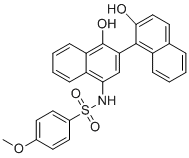C188-9
This product is for research use only, not for human use. We do not sell to patients.

For small sizes, please check our retail website as below: www.invivochem.com
| Size | Price | Stock |
|---|---|---|
| 250mg | $1150 | Check With Us |
| 500mg | $1650 | Check With Us |
| 1g | $2475 | Check With Us |
Cat #: V3113 CAS #: 432001-19-9 Purity ≥ 98%
Description: C188-9 is a novel, potent and orally bioavailable STAT3 inhibitor that binds to STAT3 with high affinity (KD=4.7±0.4 nM).
Top Publications Citing Invivochem Products
Publications Citing InvivoChem Products
Product Promise

- Physicochemical and Storage Information
- Protocol
- Related Biological Data
- Stock Solution Preparation
- Quality Control Documentation
| Molecular Weight (MW) | 471.52 |
|---|---|
| Molecular Formula | C27H21NO5S |
| CAS No. | 432001-19-9 |
| Storage | -20℃ for 3 years in powder formr |
| -80℃ for 2 years in solvent | |
| Solubility In Vitro | DMSO: 94 mg/mL (199.4 mM)r |
| Water: < 1mg/mLr | |
| Ethanol: 6 mg/mL (12.72 mM) | |
| SMILES Code | O=S(C1=CC=C(OC)C=C1)(NC2=C3C=CC=CC3=C(O)C(C4=C5C=CC=CC5=CC=C4O)=C2)=O |
| Synonyms | C 188-9; C188-9; C-188-9; C-1889; C 1889; C1889; C-1889; F0808-0084 |
| Protocol | In Vitro | C188-9 is a Stat3 inhibitor, with a Kd of 4.7 nM. The IC50s of C188-9 to inhibit Stat3 activation in AML cell lines are in the range of 4-7 μM, and in primary AML samples the IC50s are in the range of 8-18 μM. For apoptosis studies, AML cell lines and primary samples are treated for 24 hours with C188-9, then apoptotic cells are quantified by FACS analysis for annexin V-labeled cells. The EC50s for apoptosis induction are quite variable, ranging from 6 μM to over 50 μM |
|---|---|---|
| In Vivo | Of the approximately 13,528 discernible genes, levels of 37 gene transcripts are altered by C188 (17 down and 20 up-regulated, fdr <0.01, fold change≥1.5), of which 7 are known STAT3 gene targets. In comparison, C188-9 affects a much greater number of genes involved in oncogenesis (384 total, 95 down- and 289 up-regulated), including 76 genes previously reported as regulated by STAT3 (38 down-regulated and 38 up-regulated). Among the 38 genes previously shown to be upregulated by STAT3, 24 (63%) genes are downregulated by C188-9 treatment, as expected. Additionally, 10 more genes downregulated by C188-9 (fdr <0.01, fold change≥1.5) that previously are shown to be upregulated by STAT1. Thus, 40 of 48 (83.3%) genes downregulated by C188-9 previously are shown to be positively regulated by STAT1, including sixteen genes shown to be co-regulated by STAT3 and STAT1. This analysis raises the possibility that the effect of C188-9 on gene transcript levels in HNSCC tumors is mediated by its effects on both STAT3 and STAT1 |
These protocols are for reference only. InvivoChem does not
independently validate these methods.
| Solvent volume to be added | Mass (the weight of a compound) | |||
|---|---|---|---|---|
| Mother liquor concentration | 1mg | 5mg | 10mg | 20mg |
| 1mM | 2.1208 mL | 10.6040 mL | 21.2080 mL | 42.4160 mL |
| 5mM | 0.4242 mL | 2.1208 mL | 4.2416 mL | 8.4832 mL |
| 10mM | 0.2121 mL | 1.0604 mL | 2.1208 mL | 4.2416 mL |
| 20mM | 0.1060 mL | 0.5302 mL | 1.0604 mL | 2.1208 mL |
The molarity calculator equation
Mass(g) = Concentration(mol/L) × Volume(L) × Molecular Weight(g/mol)
Mass
=
Concentration
×
Volume
×
Molecular Weight*
The dilution calculator equation
Concentration(start)
×
Volume(start)
=
Concentration(final)
×
Volume(final)
This equation is commonly abbreviated as: C1 V1 = C2 V2
Concentration(start)
C1
×
Volume(start)
V1
=
Concentration(final)
C2
×
Volume(final)
V2
Step One: Enter information below
Dosage mg/kg
Average weight of animals g
Dosing volume per animal µL
Number of animals
Step Two: Enter the in vivo formulation
%DMSO
+
%
+
%Tween 80
+
%ddH2O
Calculation Results:
Working concentration:
mg/ml;
Method for preparing DMSO master liquid:
mg
drug pre-dissolved in
µL
DMSO(Master liquid concentration
mg/mL)
,Please contact us first if the concentration exceeds the DMSO solubility of the batch of drug.
Method for preparing in vivo formulation:
Take
µL
DMSO master liquid, next add
µL
PEG300, mix and clarify, next add
µL
Tween 80,mix and clarify, next add
µL
ddH2O,mix and clarify.
Note:
- (1) Please be sure that the solution is clear before the addition of next solvent. Dissolution methods like vortex, ultrasound or warming and heat may be used to aid dissolving.
- (2) Be sure to add the solvent(s) in order.




































